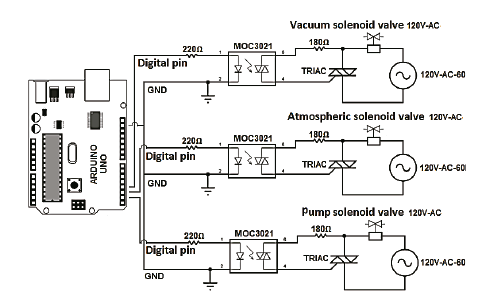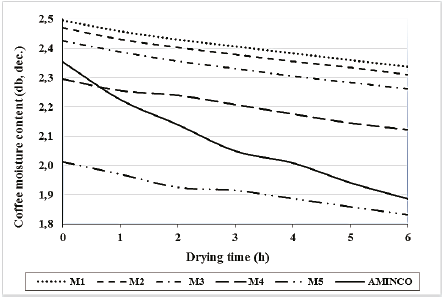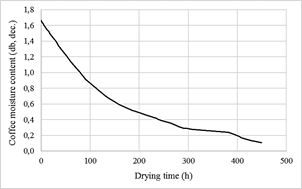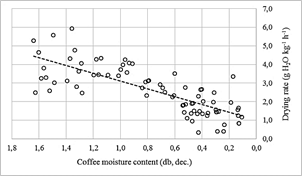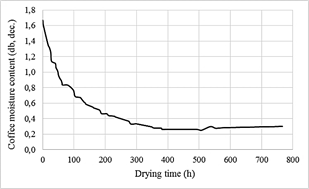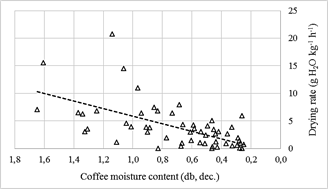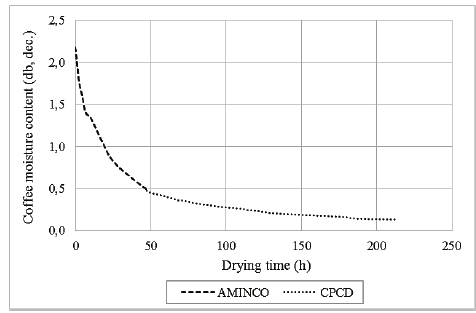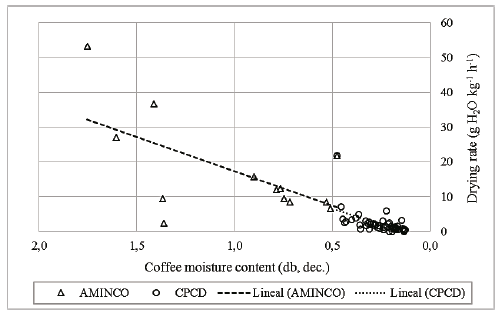1. Introduction
Coffee is one of the most commercialized products in the world. After wheat and sugar, it is the most important food product, a crop from which approximately 25 million families obtain their livelihoods in more than 50 countries in the tropics and subtropics [1]. In recent years, the coffee sector in Colombia has shown a decrease in its profitability, due to the instability of international grain prices. The largest amount of coffee (Coffea arabica) produced in Colombia is marketed on the New York Stock Exchange as excelso coffee, at prices around US $ 1.00 per pound [2]. This excelso coffee often does not reach the point of balance, so that the coffee grower recovers the investment made in the production chain.
To make the Colombian coffee growing sustainable, greater sector productivity is required, either by reducing production costs and / or improving revenues in the commercialization process. Within this last option, an alternative to make Colombian coffee production profitable is to place a greater volume of the so-called “special coffees” in the international market. These are high quality coffees, with which it is possible to obtain better prices in the international market, thanks to the growing demand for its taste and health benefits [3,4]. This alternative becomes an opportunity to increase the income of small producers and thus improve their quality life.
The “special coffees” include different types of coffee, with consistent attributes (physical, sensory), verifiable and sustainable, which differentiate them from the common coffees and for which consumers are willing to pay higher prices [3,4].
The quality of coffee depends on a large number of factors that include from the species and variety to preparation for consumption [5]. Other factors are the weather conditions of cultivation, the harvest of only ripe fruits and all the activities of post-harvest benefit that include the bioclimatic environment of benefit facilities, drying, transport and storage [6,7].
The benefit process largely defines the quality of coffee, fundamentally in three different processes: Dry or "Natural" Benefit (NB), Wet Benefit (WB) and Semi-Dry Benefit or "Honey" (BHo). In the Natural Benefit, cherries are exposed to the sun for drying during several days, allowing the seed to be impregnated with the sugars and other compounds present in the coffee pulp and mucilage, and achieving a final drink with characteristic fruity flavors [8]. If the weather conditions are not favorable, the drying process can be prolonged too much, reaching to present sour and earthy cups, with ferment defects and heavy body [8,9].
In the “wet benefit”, the most used in Colombia, the epicarp or pulp and the mesocarp or mucilage that cover the beans are removed from the fruits, obtaining washed parchment coffee with an average moisture content of 53% bh. Then, the drying process starts immediately in order to preserve the quality of the beans [8,10]. The drink obtained by this route is soft, with intense toasted, fruity or herbal sweet aromas, moderate bitterness, pleasant acidity and a clean cup. However, if there are failures in the depulping, fermentation, washing and drying processes of the grain, the cup may have defects such as ferment, rancid, vinegar, moldy, phenol, earthy and dirty [9].
In the semi-dry benefit or "Honey", the pulp of the fruit is partially or totally removed, leaving the grain covered with the mucilage and the pulp, which adhere to the grain during the sun drying process or under cover [8]. The drink obtained through this process presents chocolate, red and roasted flavors, when the benefit is under humid environmental conditions, typical of the central coffee zone of Colombia. However, when there is no control in the process, defects such as vinegar and ferment flavors may be generated [9].
If it is not carried out properly, drying is a process that can affect the quality coffee, presenting influence on the grain sugar content [11-13], as well as other undesirable chemical alterations, which lead to the loss of the physical and sensory quality of the drink, affecting color, aroma and flavor [14]. When the drying process is carried out in fixed-bed dryers with hot air, using drying air temperatures above 40°C for natural coffee and 50°C for parchment coffee, it has negative effects on the grain physical quality and the body of the drink [5,15].
There is a drying technique suitable for heat-sensitive products, whereby it is possible to maintain volatile substances that determine sensory quality, as in the case of coffee. This technique consists in removing moisture by applying Cyclic Pressure Changes (CPCD) in a chamber that contains the product to dry. There are several positive effects that have been reported so far, such as the reduction of nutrient loss, less negative effects on quality (color, shrinkage, texture and hydration) and faster drying speed [16,17].
The Cyclic Pressure Change Drying (CPCD) has been evaluated for drying heat sensitive vegetables [16-18], extracting essential oils [21-23], reducing biological contamination [24,25] and in the pretreatment for obtaining starch [26,27] and producing snacks [28].
The aim of this research was to carry out preliminary studies of drying of natural coffee by implementing a Cyclic Pressure Changes drying equipment, in order to compare this drying with solar drying systems and conventional drying by forced air convection to low temperature, from the point of view of drying times and sensory quality.
2. Materials and methods
2.1. Cyclic Pressure Change Drying Equipment - CPCD
Based on the physical properties of natural coffee, a prototype of CPCD equipment was designed and built. The equipment is composed of a vacuum chamber (drying chamber), with a capacity of 0.0189 m3 that allows 1 kg to be processed per test. The chamber allows to maintain the vacuum over time, while the water is removed from the grain. Based on the volume of the drying chamber, the capacity of the pump was calculated, thus selecting a commercial pump model 2RS-3 of 7 cfm, vacuum of 3x10-1 Pa, 110V, 60Hz and power of 0.75 HP (Fig. 1).
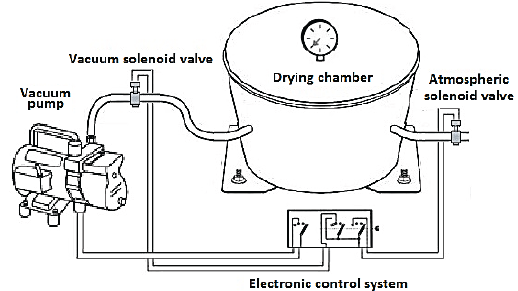
Source: The Authors
Figure 1 CPCD equipment diagram: 1) drying chamber, 2) vacuum pump, and 3) control system with regulating valves for cyclic pressure changes.
The mechanical operation of the equipment is as follows. The pump generates the vacuum and extracts the air from the drying chamber, the vacuum is regulated by an electrovalve (Electrovalve Vacuum), which opens and closes according to the time of the drying cycle. When the time is completed, the vacuum electrovalve closes and the electrovalve that controls the atmospheric pressure opens to complete the cycle and recover the pressure in the chamber.
The electronic system designed for the equipment controls the starting of the pump and the opening and closing of the electrovalves. This electronic control system was designed in two stages: the control stage and the power stage (Fig. 2).
The control stage consists in an Arduino UNO with an algorithm programmed to send a digital signal that activates or deactivates the power stage. The signal regulates the opening and closing of the electrovalves according to the vacuum times, and also switches the pump on and off.
The power stage is composed of three independent lines activated by the digital signal (5VDC) of the control stage that activates the power stage at 120VAC. Each line consists of a MOC 3021 optocoupler, a TRIAC BT138, two resistors from 220Ω and 180Ω, and a solenoid valve at 120VAC. The first line controls the vacuum input, the second line the atmospheric pressure output and the third line the pump activation.
2.2. Plant material and location
The tests were carried out in the Laboratory of Postharvest of Agricultural Products, in the School Engineering at the Universidad Nacional de Colombia - Bogotá Campus (4°38'24" N, 74°5'24" W, 2550 m.a.s.l.). The average conditions were temperature of 20°C and relative humidity of 70%, in the harvest coffee periods between July 2017 and May 2019.
Natural coffee (cherry coffee) (Coffea arabica var. Castillo) from different production areas was used for the different tests. The moisture content of coffee was determined according to Colombian Technical Standard NTC 2325 [29], using a forced convection oven at a temperature of 105°C for 16 h (WTB Binder 78532 Tuttlingen / Germany, temperature range 0 - 300°C) and a Precisa XT220A analytical balance, with 220 g capacity and 0.0001 g precision (Precisa Instruments, Zurich, Switzerland).
2.3. CPCD equipment calibration
Preliminary drying tests were carried out with 7 kg of natural coffee from the municipality of Choachi - Cundinamarca (4°31'30" N, 73°54'28" W, 1820 m.a.s.l.). In the CPCD equipment, five calibration tests were carried out with 1 kg of natural coffee each, maintaining a cycle of one pressure drop per minute (Table 1). The remaining 2 kg of natural coffee were subjected to a thin layer drying test by forced air convection (T = 40°C, RH = 22.3%) in the AMINCO environment conditioning unit, in order to compare the two methods of drying and to establish parameters for programming the following tests with the CPCD equipment. In all cases, a drying time of 6 hours was maintained, the sample weight was recorded every hour until the end of each test.
2.4. Experimental design
Considering the results obtained from the preliminary tests (Table 1), the optimal working ranges of the equipment were identified. With these values, an experimental design was carried out using the CCD (Central Composite Design) methodology in order to determine the point optimal operation of the equipment. This method was chosen because it fits the behavior found in the preliminary tests and the evaluated variables (atmospheric and vacuum pressure times). Once the data in the CRAN / R statistical package was analyzed, the tests to be performed were determined.
2.5. Drying tests
Two drying tests were carried out. The first one used natural coffee from the municipality of Samaná - Caldas (5°24'36 "N, 74°59'24" W, 1463 masl). From this coffee, 3.5 kg were placed in the drying chamber (in thin layers) of the CPCD equipment, with vacuum and atmospheric pressure times of 15 s and 3 s respectively, as defined in the experimental design. Then, 4.0 kg of coffee were available in the "Pasera"-type solar dryer with an area of 2.8 m2 and exposed in open space under the prevailing climatic conditions at the Universidad Nacional de Colombia - Bogotá Campus (Average conditions: T = 14°C; HR = 76%; predominance of rainy days).
Natural coffee produced in the municipality of Fusagasugá - Cundinamarca (4°20'24" N, 74°21'36" W, 1717 m.a.s.l.) was used for the second drying test. This coffee was transported in a temperature controlled refrigerator to the laboratory, in order to avoid deterioration of the product associated with high temperature fermentation. Afterward, 3.0 kg of natural coffee were available in the drying chamber of the environment conditioning unit - AMINCO, to perform conventional drying by forced convection of low temperature air (35°C), until a final moisture content of 11% wb (0.124 db). Other 3.0 kg of natural coffee were subsequently dried in the AMINCO unit to a moisture content of 32% wb (0.47 db), then the coffee was dried in the CPCD equipment until it reached a moisture content of 11% wb (0.124 db).
Weight measurements of the coffee samples were made with a frequency of 2 hours during the drying tests experimentation periods.
3. Results and discussion
3.1. CPCD equipment validation and calibration tests
Table 2 shows the results obtained in the preliminary drying tests using the CPCD equipment and the forced convection dryer in the AMINCO environment conditioning unit. For the M1 and M2, thick layer samples were subjected to vacuum pressure during 108 s. Average drying rates of 7.72 and 7.63 g H2O kg coffee-1 h-1 were obtained for M1 and M2, respectively. The M3 sample was evaluated in a thick layer with a vacuum pressure time of 118 s, obtaining an average drying rate of 8.2 g H2O kg coffee-1 h-1. These preliminary results indicate that at higher vacuum pressure times there will be higher speeds or drying rates.
Table 2 Moisture content and drying rate in preliminary tests of natural coffee.
| M1 | M2 | M3 | M4 | M5 | C.F.-AMINCO | |||||||
|---|---|---|---|---|---|---|---|---|---|---|---|---|
| Hours | a | b | a | b | a | b | a | b | a | b | a | b |
| 0 | 2.495 | -- | 2.471 | -- | 2.425 | -- | 2.294 | -- | 2.012 | -- | 2.353 | -- |
| 1 | 2.457 | 6.7 | 2.431 | 5.9 | 2.388 | 6.5 | 2.255 | 5.7 | 1.971 | 4.1 | 2.225 | 12.9 |
| 2 | 2.429 | 6.8 | 2.403 | 6.8 | 2.356 | 6.5 | 2.239 | 8.1 | 1.926 | 10.7 | 2.139 | 17.3 |
| 3 | 2.406 | 6.8 | 2.379 | 6.9 | 2.331 | 7.5 | 2.208 | 10.9 | 1.915 | 10.8 | 2.049 | 21.1 |
| 4 | 2.382 | 6.8 | 2.355 | 7.0 | 2.305 | 7.8 | 2.176 | 11.2 | 1.887 | 10.9 | 2.008 | 27.0 |
| 5 | 2.359 | 8.3 | 2.335 | 7.9 | 2.284 | 9.6 | 2.145 | 11.4 | 1.859 | 16.2 | 1.941 | 28.2 |
| 6 | 2.336 | 10.9 | 2.310 | 11.3 | 2.262 | 11.3 | 2.123 | 14.0 | 1.832 | 17.5 | 1.886 | 40.3 |
| Mean± SD | 7.7±1.5 | 7.6±1.7 | 8.2±1.7 | 10.2±2.6 | 11.7±4.3 | 24.4±8.8 | ||||||
a: Coffee moisture content (db, dec.)
b: Drying rate (g H2O kg coffee-1 h-1)
Source: The Authors
The M4 and M5 tests were carried out in a thin layer applying vacuum pressure for a time of 118 s. Average drying rates of 10.22 and 11.7 g H2O kg coffee-1 h-1 were obtained for M4 and M5, respectively. When comparing the values obtained in thick layer with those of thin layer, it is evidenced that the drying rate increases as it has a lower product thickness, allowing an adequate passage of air through the drying chamber. Likewise, the speed or rate of drying in the equipment of cyclic changes in pressure (CPCD) is lower compared to the drying rate in a forced air convection system (AMINCO), where rates of 24.4 g H2O kg coffee-1 h-1 were reached.
Fig. 3 shows that the curves corresponding to tests M1, M2, M3, M4 and M5 have a constant and similar slope during the entire drying process, regardless of the initial moisture content of coffee cherries. This indicates that the drying rate is relatively constant for cyclic pressure changes (CPCD), which does not occur when forced convection drying (AMINCO) is used. The forced convection drying curve has drying rates that vary over time, being higher at the beginning of the process and decreasing as the drying progresses. This is the typical behavior in the forced convection drying systems of air [10,30].
Taking into account the results obtained from the preliminary tests, using the CCD (Central Composite Design) methodology and after analyzing the data in the CRAN/R statistical package, the default vacuum and atmospheric pressure times were set at 15 s and 3 s, respectively. This were the best functioning conditions obtained in the first readjustment in the design of the equipment. With these vacuum and atmospheric pressure times the following drying tests were performed. Results of the validation tests indicate that the CPCD equipment worked properly and that it is a viable drying technology to obtain “specialty coffees”.
3.2. First drying test
The process began with a moisture content of 62.5% bh (1.67 bs) and ended with a moisture content of 10.4% bh (0.116 bs), both for drying in the CPCD equipment and in the “Pasera”-type solar dryer. Figs. 4, 5 show the drying curve and the drying rate of natural coffee, respectively, obtained during the drying process in the CPCD equipment.
Figs. 6, 7 show the drying curve and the drying rate of natural coffee, respectively, obtained in the “Pasera”-type solar dryer. In the solar drying of natural coffee, the environmental conditions of temperature and relative humidity are the ones that mainly influence the drying process [13].
Taking into account the tests carried out, it is evident that the drying process in the CPCD equipment obtained a lower moisture content in a shorter time interval than in the solar dryer, with drying times of 449 hours and 767 hours, respectively. In the solar dryer, the moisture content at the end of the process was 23.1% bh (0.30 bs), due to the equilibrium achieved with the prevailing climatic conditions during the test. In consequence, it was necessary to continue with the forced convection drying process in the AMINCO environment conditioning unit, until it reached the desired final moisture content.
Regarding the drying rate, a more linear and homogeneous trend is observed in the CPCD equipment, with positive drying rates ranging from 5.93 g H2O kg-1 h-1 at the beginning of the process to 0.4 g H2O kg-1 h-1 at the end of drying. The lower rate at the end of the process is a typical drying behavior of agricultural products, since the adhesion forces of the water molecules to the dry matter of the product are greater as the moisture content decreases, thus requiring greater energy for removal [10,30].
In the “Pasera”-type solar dryer, it is observed that the drying rates are a little more dispersed with respect to the linear trend and reaching negative values. This indicates the rewetting of the grains due to the prevailing climatic conditions in the place during the test drying, which can negatively affect the final quality of the grain [8,9].
3.2.1. Coffee quality assessment
At the end of drying, a cup quality test of the coffee samples was carried out by Tritocafé S.A.S., which is company with experience in the coffee industry. A score of 80 was obtained for the coffee processed in the CPCD equipment, which is the limit of a special coffee [31], and 76 for coffee processed in the solar dryer. The score given to the sample obtained from the CPCD equipment is at the lowest limit of a special coffee, which may have been higher. This is explained by the improper handling given to natural coffee after harvest, such as uncooled transport from far away production areas to the post-harvest laboratory of the Universidad Nacional de Colombia - Bogotá Campus. Improper handling caused fermentation processes in cherry coffee beans, resulting in the degradation of pulp sugars and the consequent loss of quality [8,9]. However, in the drying by cyclic pressure changes (CPCD) the properties of coffee are better preserved than in the traditional solar drying process, in which a score lower than that of a special coffee was obtained [31].
3.3. Second drying test
The natural coffee drying process began with a moisture content of 68.5% bh (2.18 bs) in the AMINCO environment conditioning unit (forced air convection at a temperature of 35°C) and achieved a moisture content of 32% bh (0.47 bs) after 47 h. Then, this coffee was placed in the CPCD equipment in thin layers to continue drying until reaching a final moisture content of 11.3% bh (0.128 bs), where it remained for 166.5 h, for a total drying time of 213.5 h (8.9 days). The grain remained in the CPCD equipment for 78% of the total time, with low drying rates (less than 7.1 g H2O kg-1 h-1). However, at this stage the moisture that had to be removed was the most strongly adsorbed (less than 0.47 bs), which makes it difficult to extract moisture from the grain [10,30]. Figs. 8, 9 show the drying curve and the drying rate of natural coffee, respectively, obtained using the combined AMINCO-CPCD system
Figs. 10, 11 show the drying curve and the drying rate of natural coffee, respectively, obtained in the AMINCO environment conditioning unit, using forced air convection at a temperature of 35°C. The process began with a moisture content of 67.2% bh (2.05 bs) and ended with a moisture content of 12.0% bh (0.136 bs).
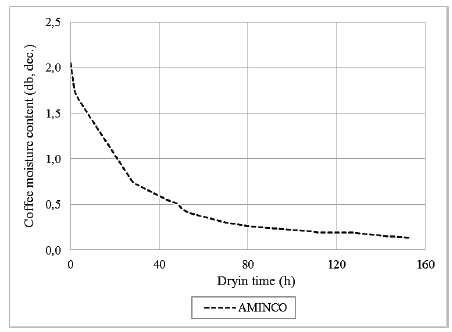
Source: The Authors
Figure 10 Natural coffee drying curve obtained using AMINCO forced air convection dryer
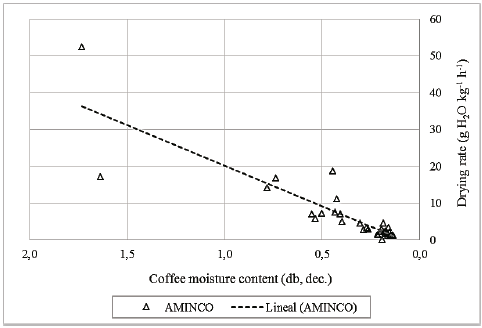
Source: The Authors
Figure 11 Natural coffee drying rate obtained using AMINCO forced air convection dryer
The process of drying with forced air occurred faster than in the combined system, with a duration of 153.5 hours (6.4 days). When comparing the evaluated methods, the difference in drying times is 2.5 days, that is, 39% more time in the AMINCO-CPCD combined drying system. Using forced convection with heated air (T = 35°C) generates a greater difference between the vapor pressure of the drying air and the vapor pressure of the water contained in the product, causing water to be eliminated more quickly [28]
3.3.1. Coffee quality assessment
In order to evaluate the goodness of the drying methods used, an evaluation of the cup quality of each sample obtained was performed. The test was carried out by Tritocafé S.A.S. and gave a score of 87 for the coffee obtained by means of the combined drying AMINCO-CPCD. This indicates that it is a coffee with excellent characteristics, thus classified as a special coffee. With respect to the coffee dried only with forced air at a temperature of 35°C in the AMINCO environment conditioning unit, the cup score was 84, which is also of excellent quality, but with lower cup attributes than the coffee obtained by the combined system AMINCO - CPCD
These results show that the use of the dryer by cyclic pressure changes - CPCD is beneficial at the end of the drying process, which is the period in which the water is retained with greater intensity in the grain requiring more energy for its removal. The CPCD do not use high temperatures that can cause degradation of important components in the quality of the beverage [5], such as sugars [11-13] and other volatile substances that define the aroma and taste of the beverage [14]. Therefore, this system is ideal to preserve the characteristics of a special coffee.
The goodness of drying by cyclic pressure changes (CPCD) is explained by the use of vacuum in the process of extracting moisture from the grains, which is carried out at very low temperatures. This method is suitable for drying products that can lose volatile substances due to high temperatures [5,16,17]. This is the case of coffee, whose main characteristic of high-quality is represented by volatile components, which determine the organoleptic properties (aromatic and tasting) [5,11,14].
4. Conclusions
The results obtained indicate that the new method of drying proposed for coffee (CPCD dryer) is an excellent alternative to obtain high-quality specialty coffees. Compared to the best drying alternatives currently used, the cups with grains dried in this system present cup quality assessment tests with scores much higher than those obtained by other methods.
These preliminary drying tests using the CPCD dryer are a great opportunity to conduct research on coffee drying aimed at establishing the methodologies and operating parameters for obtaining different types of specialty coffees. For future research, it is recommended to carry out non-parametric cup tests, in order to highlight the different organoleptic properties of the obtained coffee (cup profile).













